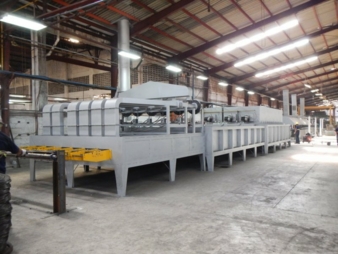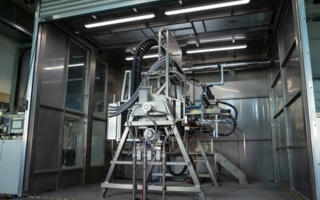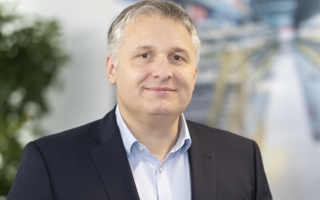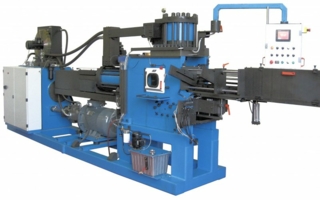04/08/2020 – Heat treatment
The Fritz continuous wire annealing furnace
The thermal economy of the Fritz furnace becomes evident when considering that the waste gases go into the chimney with only about 300°C.
In most galvanizing lines for low carbon wire is installed a continuous annealing furnace. Apart from annealing the wire to a tensile strength of (usually) 40kg/mm² to 45kg/mm², the furnace also has the purpose of eliminating the lubricants from wire drawing, as these may influence the galvanizing quality (lubricants are not eliminated by the pickling). Compared to other annealing furnace types (lead bath furnaces, fluidized bed furnaces, muffle or open fire furnaces), the Fritz continuous wire annealing furnace is economic, having low energy consumption. Furnaces with a high throughput capacity have a consumption of about 750MJ/t – 800 MJ/t of annealed wire.
The furnace consists of three zones, the length being in function of wire passage speed. On top of the last zone (in the direction of the wire passing), the combustion chamber, sits a light weight cover lined with ceramic fibre. Even on big furnaces, no more than three (fully automatic) burners are installed on the cover. Thanks to its low weight, the heating cover can easily be taken off, and in the other two furnace zones, there is little brickwork above the wire channels (this is advantageous when it becomes necessary to access these).
The waste gases of the combustion chamber are aspired by special heat-resistant fans to the furnace entrance. The wires pass the furnace against the heat current, the high waste gas speeds giving excellent heat transfer by convection. The thermal economy of the Fritz furnace becomes evident when considering that the waste gases go into the chimney with only about 300°C. Furthermore, at these low temperatures at the furnace inlet, the lubricants on the wires may evaporate rather than being burned (burnt lubricants on the wire surface can likewise compromise the galvanizing quality).
In the furnace the wires run in special grooved bricks to avoid wire roping. The furnace is equipped with a cleaning channel (scale). At the furnace entrance a wire straightening device with adjustable grooved roller bearings is installed, to guide the wires coming from the pay-off correctly into the furnace.
Their standard design has 8, 10 or 12 wires per channel, with 1 to 6 channels per furnace. The furnace can be designed for producing soft and hard wires (higher tensile strengths) simultaneously, for example 20 wires at high temperature and 10 wires at low temperature, or vice versa. Very fine wires (less than 1.2mm diameter) are generally annealed in a bell annealing furnace, because they might break in the continuous wire annealing furnace. However wires down to 0.6mm diameter have been annealed in the continuous furnace.
To date, Fritz has supplied 37 continuous wire annealing furnaces of this type, for up to 60 wires, with capacities in excess of 6.000kgs/h, and from 10m to 28m length. Quite some furnaces have been delivered on local manufacture basis, which means that the customer can purchase the steel constructions and standardised materials locally, according to the drawings and detail lists. This not only reduces the price, but also allows saving on transport costs.
Ofenbau Fritz
Tel.: +49 2334 2884




